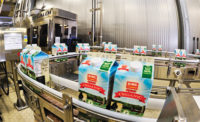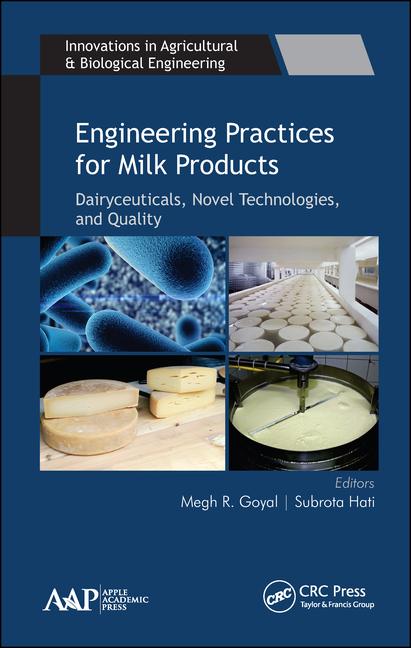Plant of the Year
The Michigan Milk Producers Association spent $62 million to renovate a facility in Ovid, Mich. This new plant operates seven days a week, 24 hours a day. It's the 2010 Plant of the Year.

A two-year, $62 million expansion completed in April boosted a plant’s daily capacity to 5 million pounds of milk, which is converted into high-value, high-volume dairy ingredients, including cream, condensed skim milk, butter and milk powders. The expansion included a $27 million tower dryer, $7 million in mechanical vapor recompression (MVR) equipment and $28 million in receiving, processing, utility and warehousing improvements and additions.
For these reasons, Dairy Foods honors the Ovid, Mich., facility of the Michigan Milk Producers Association as the 2010 Plant of the Year. The dairy cooperative, which ranks 59th on this magazine’s Dairy 100 list of the nation’s largest processors, is based in Novi.
The plant operates seven days a week, 24 hours a day to handle roughly one-third of raw milk production from nearly 2,200 producer members. The remainder of the cooperative’s milk is delivered directly to customers from member farms, with about 5 million pounds a week processed at a butter/powder plant in Constantine.
Consistent raw milk production gains by the MMPA producer member base in Michigan, Indiana, Ohio and Wisconsin, combined with supply-demand fluctuations, drove the Ovid expansion. The alternatives – limiting producer growth or shipping milk outside of the Great Lakes region – did not support the co-op’s mission to provide members with the best possible milk price.
“Ovid is our workhorse. It allows our cooperative to do more. This is the plant where we can push the volume that we need,” says Clay Galarneau, MMPA general manager.
Milk demand shifts by the day and the season, particularly in the case of fluid milk bottlers, which provide co-op members with the best available price under the federal milk marketing order.
“We allow our customers to order what they need, daily. A lot of our customers are down on Saturday and Sunday, and on holidays. The cows produce milk every day,” Galarneau says. “This added capacity not only helps us with the balancing swings, but also helps us more effectively meet the needs of our growing dairy manufacturing customers here in the Great Lakes region. It also allows our members to increase production and have a secure home for the milk.”
MMPA’s total manufactured product sales reached $273 million for the fiscal year ending Sept. 30. The Ovid plant contributed $218 million, a 62% jump from 2009. The next year will be its first full year online, and management predicts the plant will bring in $233 million.

Ovid’s regional customers include yogurt, ice cream and cheese processors. Powder customers use MMPA’s custom powder bases to create dry consumer goods such as hot cocoa mix and infant formula. Fluid cream and condensed skim milk is blended to customer specification for solids and butterfat. The plant’s butter is utilized by baked-goods and other food processors. Products are also exported, an area with increased focus for the co-op, a founding and long-term member of the U.S. Dairy Export Council.
The plant expansion and addition of the new tower dryer creates new flexibility and product capabilities, including agglomerated, whole milk and high-heat powders. “What we’d like to have is almost infinite flexibility, and we’re getting closer and closer,” Galarneau says.
MMPA’s manufactured product sales to regional food processors are on the rise. MMPA has enjoyed steady growth bolstered by the increasing popularity of the yogurt category.
The expansion provides “plug-and-go” capabilities to ease future installation of potential processing and packaging needs. “We can buy the add-ons as we need them and as we can afford them,” Galarneau says.
For instance, product is currently transferred from the finisher/evaporator to the new tower dryer via one feed system, which must be sanitized daily. That is a four-hour process that limits new dryer runs to only 20 hours a day. But the dryer is plumbed to accept a second feed system, which would allow the dryer to run 30 days continuously and increase processing capacity by 20%, “a much smaller-scale investment to get some big payouts,” Galarneau notes.

If a customer’s plant unexpectedly breaks down or if a weather event knocks out power to the state, Ovid is ready.
“Other people’s problems become ours, because it’s our members’ milk that will be sitting in a parking lot otherwise,” says David Wittkop, director of operations.
Conversely, the balancing role of the Ovid plant means it is engineered to instantly address processing challenges with multiple available processing lines and “extra” equipment such as pumps.
“It’s an investment to have a piece of equipment that is not being utilized, one that is sitting and waiting. In a perfect world, we would have two of everything. In many cases we do,” Wittkop says.
Equipment duplications throughout the facility allow continuous operation by providing switchover capabilities. For instance, the surge pan that supplies milk to the entire system must be sanitized every six hours to meet regulatory standards. So the Ovid plant has two surge pans; every four hours it changes over, a flip-flop that keeps the milk flowing and minimizes start-up and shut-down times.
“We don’t have the down time. We run day in and day out,” explains Gasper Calandrino, Ovid’s manager of engineering and maintenance. “We have a lot of built-in redundancy, but we don’t have two plants here. To consistently run at full capacity, that means we have to do a lot of things on the preventative maintenance side to ensure our systems are capable of running at capacity.”
The expansion included $4 million for three backup generators and diesel fuel storage. The 6 megawatts of emergency power kick on within 15 seconds of an outage, and allow the plant to operate off the grid for 24 hours before refueling.
Cross-training, multitasking and a flexible workforce are key to filling the plant’s labor needs. During peak milk processing periods, seasonal labor joins union employees.
“An individual has one job, but he may learn how to perform four jobs. That way he is able to move around as needed in a floater capacity,” Stewart says.
Efficient workforce deployment and integrating the expansion into existing processing capabilities combine to create highly automated lines. Pre-expansion, the two separators were run by one operator; post-expansion, the same operator runs three separator lines.
Although processing is highly automated, the increased facility volume has required the addition of 10 new employees to the labor-intensive milk receiving and packaging/warehousing departments.
Prior to the $62 million expansion, MMPA invested $4.8 million in sanitation and process flexibility improvements at the Ovid facility. A plant-wide control network now feeds data into the facility’s supervisory control and data acquisition (SCADA) system. SCADA creates continuous monitoring of operations, provides details for troubleshooting and plays a key role in improving the plant’s manufacturing efficiency.
The plant’s quality department performs a monthly internal food safety audit, and also uses third-party GMA-safe audits. Customers are increasingly also requiring additional documentation geared toward specific needs. “Our recall system gives us the ability to trace products in minutes. It’s highly sophisticated,” says Bill Rann, Ovid’s quality assurance manager.
Raw whole milk is pumped from storage silos to one of three centrifugal hot milk separators, where centrifugal force spins 80,000 pounds per hour into raw skim and raw cream components.
Raw cream is piped directly to a high temperature short time unit (HTST) plate heat exchanger, where it undergoes legal pasteurization. Pasteurized cream is stored in dedicated storage silos to await customer shipments or Ovid butter processing.
Ovid’s butter line includes no salt, salt, natural flavored, lactic acid flavored, and 2% salted varieties Pasteurized cream is aged in the silos prior to processing to enhance solidification during churning. Finished butter is extruded into a butter boat, which acts as a surge tank to supply to the packaging line. Butter is packaged in 55-pound (25 kilogram) polyethylene-lined, corrugated boxes. It passes through the in-line metal detector, and then is dated, coded, palletized and transferred to refrigerated storage by fork lift.
Raw skim milk is held in dedicated silos for further processing. It is pumped to the new MVR equipment to condense skim milk for customers and as a pre-concentration step for milk designated to become powder. Turbofans create compression and heat which pasteurizes the skim milk and reduces its water content by 40%.
“We’re doing the grunt work up front so that the evaporators can work more easily,” Wittkop says.
The new MVR room adds 56% to the capacity of the plant’s two original evaporators by pre-concentrating skim milk solid levels from 9% to about 14%. Concentrated skim milk is held in pasteurized storage silos for customer delivery or for further processing into dry milk powders.
Condensed skim milk for powder continues to the plant’s multilevel evaporator room or to a new evaporator/finisher in the tower dryer area. Evaporator/finishers operate under a vacuum and blast milk with steam to further concentrate the fluid to 45% solids. Water is drawn off in a succession of effects from the evaporators. The concentrated fluid is pumped into one of the plant’s original two box dryers or the new tower dryer.
The condensed milk travels from the evaporators into an overhead conduit to the new single-effect evaporator, is reduced to 50% solids and is then pumped into the ten-story-high tower dryer at 3,500 psi. The milk is sprayed into the dryer, where low vacuum pressure and super-heated temperatures combine to atomize condensed milk into dry particles at 10,000 pounds per hour capacity.
A rotary packaging line fills 50-pound bags, which pass through a bag sealer and the in-line metal detector, and are then palletized. A bulk filling station handles 2,000-pound totes. Expanded by 22,000 square feet, the warehouse has storage for more than 7.2 million pounds of finished powder products.
In addition to obvious efficiency and volume benefits, the standout plant expansion reduced the co-op’s carbon footprint in a very simple way, Galarneau says.
“We built the expansion where the milk is.”
Total processing capacity: 5 million pounds of milk daily (average 4.4 million pounds), 1.5 billion pounds annually.
Products made: Butter, nonfat dry milk powder, whole milk powder, cream, condensed skim milk and specialty blends.
Number of employees: 100 in Ovid, 200 cooperative-wide
Facility history: Built in 1939; MMPA purchased in 1957. Cottage cheese processing converted to high-volume butter, powder production added, $3.4 million (1980-1981); operations/production planning flexibility renovation, $20 million (1988-1991); wastewater treatment facility built, $6.5 million (2002); process control upgrade and equipment optimization, $200,000 (2004); sanitation and process flexibility upgrades, $4.8 million (2007); tower dryer, MVR, separator, warehouse, utilities, automated controls and other additions/updates, $62 million (2008-2010).
Milk source: Nearly 2,200 MMPA producers; less than 10% from other sources.
Milk receiving: Three lane, six-bay system operates a minimum of 20 hours a day, year-round.
Separators: Three centrifugal hot milk separators, 80,000 pounds per hour.
Pasteurization: Four main HTST units, two in evaporating room (total 251,000 pounds per hour), two for cream (total 60,000 pounds per hour capacity) and multiple support units throughout facility.
Butter processing/packaging: One churn, 6,500 pounds per hour; fills 120 lined, corrugated 55-pound/25-kilogram boxes per hour.
Evaporation: Pre-concentration via mechanical vapor recompression (MVR) units. One five-effect evaporator/finisher, 100,000 pounds per hour; one six-effect evaporator/finisher, 155,000 pounds per hour (both feed to box dryers); one single-effect evaporator/finisher, 21,000 pounds per hour (feeds to tower dryer).
Drying: Two box spray dryers, each 5,000 pounds per hour; one tower spray dryer, 10,000 pounds per hour.
Powder packaging: One rotary filler, eight 50-pound bags per minute; two bulk fillers, six 2,000-pound totes per hour.
Fluid storage: Total 7.5 million pounds in 26 silos; raw milk (whole and skim), 4.8 million pounds in 10 silos; pasteurized, 2.6 million pounds in 16 silos. Evaporative condensate water storage, 1.34 million pounds (156,000 gallons) in four silos; product recovery (to pull milk solids from pre-wash down water), 505,000 pounds in two silos.
Cooler: 4,000 square feet (255,000 pounds of butter capacity).Dry warehouse storage: 75,000 square feet (7.2 million pounds powder capacity).
Distribution/load-out: Two dry product bays; one butter cooler bay; two pasteurized cream/condensed milk bays.
Utilities: Four boilers, three 1,200 horsepower, one 1,000 horsepower; three emergency backup diesel generators (total 6 megawatts for 24 hours of operation).
Wastewater facility: Two concrete sequence batch reactors, 1 million gallons each.

A two-year, $62 million expansion completed in April boosted a plant’s daily capacity to 5 million pounds of milk, which is converted into high-value, high-volume dairy ingredients, including cream, condensed skim milk, butter and milk powders. The expansion included a $27 million tower dryer, $7 million in mechanical vapor recompression (MVR) equipment and $28 million in receiving, processing, utility and warehousing improvements and additions.
For these reasons, Dairy Foods honors the Ovid, Mich., facility of the Michigan Milk Producers Association as the 2010 Plant of the Year. The dairy cooperative, which ranks 59th on this magazine’s Dairy 100 list of the nation’s largest processors, is based in Novi.
The plant operates seven days a week, 24 hours a day to handle roughly one-third of raw milk production from nearly 2,200 producer members. The remainder of the cooperative’s milk is delivered directly to customers from member farms, with about 5 million pounds a week processed at a butter/powder plant in Constantine.
Consistent raw milk production gains by the MMPA producer member base in Michigan, Indiana, Ohio and Wisconsin, combined with supply-demand fluctuations, drove the Ovid expansion. The alternatives – limiting producer growth or shipping milk outside of the Great Lakes region – did not support the co-op’s mission to provide members with the best possible milk price.
“Ovid is our workhorse. It allows our cooperative to do more. This is the plant where we can push the volume that we need,” says Clay Galarneau, MMPA general manager.
Milk demand shifts by the day and the season, particularly in the case of fluid milk bottlers, which provide co-op members with the best available price under the federal milk marketing order.
“We allow our customers to order what they need, daily. A lot of our customers are down on Saturday and Sunday, and on holidays. The cows produce milk every day,” Galarneau says. “This added capacity not only helps us with the balancing swings, but also helps us more effectively meet the needs of our growing dairy manufacturing customers here in the Great Lakes region. It also allows our members to increase production and have a secure home for the milk.”
MMPA’s total manufactured product sales reached $273 million for the fiscal year ending Sept. 30. The Ovid plant contributed $218 million, a 62% jump from 2009. The next year will be its first full year online, and management predicts the plant will bring in $233 million.

Manufactured mix
“Often with a balancing plant, the goal is to just find a home for the products. With us, that’s not the case. This facility is focused on the high-end, high-volume items that meet the market need,” says Jim Dodson, director of manufactured product sales.Ovid’s regional customers include yogurt, ice cream and cheese processors. Powder customers use MMPA’s custom powder bases to create dry consumer goods such as hot cocoa mix and infant formula. Fluid cream and condensed skim milk is blended to customer specification for solids and butterfat. The plant’s butter is utilized by baked-goods and other food processors. Products are also exported, an area with increased focus for the co-op, a founding and long-term member of the U.S. Dairy Export Council.
The plant expansion and addition of the new tower dryer creates new flexibility and product capabilities, including agglomerated, whole milk and high-heat powders. “What we’d like to have is almost infinite flexibility, and we’re getting closer and closer,” Galarneau says.
MMPA’s manufactured product sales to regional food processors are on the rise. MMPA has enjoyed steady growth bolstered by the increasing popularity of the yogurt category.
The expansion provides “plug-and-go” capabilities to ease future installation of potential processing and packaging needs. “We can buy the add-ons as we need them and as we can afford them,” Galarneau says.
For instance, product is currently transferred from the finisher/evaporator to the new tower dryer via one feed system, which must be sanitized daily. That is a four-hour process that limits new dryer runs to only 20 hours a day. But the dryer is plumbed to accept a second feed system, which would allow the dryer to run 30 days continuously and increase processing capacity by 20%, “a much smaller-scale investment to get some big payouts,” Galarneau notes.

Redundantly ready
The Ovid balancing plant combines redundancies in technology, training and staffing to handle volume swings. “The milk must flow,” says Ryon Shaw, project engineer at the Ovid plant.If a customer’s plant unexpectedly breaks down or if a weather event knocks out power to the state, Ovid is ready.
“Other people’s problems become ours, because it’s our members’ milk that will be sitting in a parking lot otherwise,” says David Wittkop, director of operations.
Conversely, the balancing role of the Ovid plant means it is engineered to instantly address processing challenges with multiple available processing lines and “extra” equipment such as pumps.
“It’s an investment to have a piece of equipment that is not being utilized, one that is sitting and waiting. In a perfect world, we would have two of everything. In many cases we do,” Wittkop says.
Equipment duplications throughout the facility allow continuous operation by providing switchover capabilities. For instance, the surge pan that supplies milk to the entire system must be sanitized every six hours to meet regulatory standards. So the Ovid plant has two surge pans; every four hours it changes over, a flip-flop that keeps the milk flowing and minimizes start-up and shut-down times.
“We don’t have the down time. We run day in and day out,” explains Gasper Calandrino, Ovid’s manager of engineering and maintenance. “We have a lot of built-in redundancy, but we don’t have two plants here. To consistently run at full capacity, that means we have to do a lot of things on the preventative maintenance side to ensure our systems are capable of running at capacity.”
The expansion included $4 million for three backup generators and diesel fuel storage. The 6 megawatts of emergency power kick on within 15 seconds of an outage, and allow the plant to operate off the grid for 24 hours before refueling.
Cross-training, multitasking and a flexible workforce are key to filling the plant’s labor needs. During peak milk processing periods, seasonal labor joins union employees.
“An individual has one job, but he may learn how to perform four jobs. That way he is able to move around as needed in a floater capacity,” Stewart says.
Efficient workforce deployment and integrating the expansion into existing processing capabilities combine to create highly automated lines. Pre-expansion, the two separators were run by one operator; post-expansion, the same operator runs three separator lines.
Although processing is highly automated, the increased facility volume has required the addition of 10 new employees to the labor-intensive milk receiving and packaging/warehousing departments.
Prior to the $62 million expansion, MMPA invested $4.8 million in sanitation and process flexibility improvements at the Ovid facility. A plant-wide control network now feeds data into the facility’s supervisory control and data acquisition (SCADA) system. SCADA creates continuous monitoring of operations, provides details for troubleshooting and plays a key role in improving the plant’s manufacturing efficiency.
The plant’s quality department performs a monthly internal food safety audit, and also uses third-party GMA-safe audits. Customers are increasingly also requiring additional documentation geared toward specific needs. “Our recall system gives us the ability to trace products in minutes. It’s highly sophisticated,” says Bill Rann, Ovid’s quality assurance manager.
Dairy processing
Milk arrives at the plant’s three-lane, six-bay receiving department in traditional as well as multi-axle, 100,000-pound-capacity super tankers. Milk samples are drawn and certified technicians perform additional quality criteria tests at the state-accredited, in-house lab. The addition of upsized pumps, mix-proof valves, improved CIP systems and added silo capacity boosted receiving capabilities from 3 million pounds of milk a day to 5 million without increasing the department’s physical size.Raw whole milk is pumped from storage silos to one of three centrifugal hot milk separators, where centrifugal force spins 80,000 pounds per hour into raw skim and raw cream components.
Raw cream is piped directly to a high temperature short time unit (HTST) plate heat exchanger, where it undergoes legal pasteurization. Pasteurized cream is stored in dedicated storage silos to await customer shipments or Ovid butter processing.
Ovid’s butter line includes no salt, salt, natural flavored, lactic acid flavored, and 2% salted varieties Pasteurized cream is aged in the silos prior to processing to enhance solidification during churning. Finished butter is extruded into a butter boat, which acts as a surge tank to supply to the packaging line. Butter is packaged in 55-pound (25 kilogram) polyethylene-lined, corrugated boxes. It passes through the in-line metal detector, and then is dated, coded, palletized and transferred to refrigerated storage by fork lift.
Raw skim milk is held in dedicated silos for further processing. It is pumped to the new MVR equipment to condense skim milk for customers and as a pre-concentration step for milk designated to become powder. Turbofans create compression and heat which pasteurizes the skim milk and reduces its water content by 40%.
“We’re doing the grunt work up front so that the evaporators can work more easily,” Wittkop says.
The new MVR room adds 56% to the capacity of the plant’s two original evaporators by pre-concentrating skim milk solid levels from 9% to about 14%. Concentrated skim milk is held in pasteurized storage silos for customer delivery or for further processing into dry milk powders.
Condensed skim milk for powder continues to the plant’s multilevel evaporator room or to a new evaporator/finisher in the tower dryer area. Evaporator/finishers operate under a vacuum and blast milk with steam to further concentrate the fluid to 45% solids. Water is drawn off in a succession of effects from the evaporators. The concentrated fluid is pumped into one of the plant’s original two box dryers or the new tower dryer.
The condensed milk travels from the evaporators into an overhead conduit to the new single-effect evaporator, is reduced to 50% solids and is then pumped into the ten-story-high tower dryer at 3,500 psi. The milk is sprayed into the dryer, where low vacuum pressure and super-heated temperatures combine to atomize condensed milk into dry particles at 10,000 pounds per hour capacity.
A rotary packaging line fills 50-pound bags, which pass through a bag sealer and the in-line metal detector, and are then palletized. A bulk filling station handles 2,000-pound totes. Expanded by 22,000 square feet, the warehouse has storage for more than 7.2 million pounds of finished powder products.
In addition to obvious efficiency and volume benefits, the standout plant expansion reduced the co-op’s carbon footprint in a very simple way, Galarneau says.
“We built the expansion where the milk is.”
At a Glance: Michigan Milk Producers Association, Ovid, Mich.
Facility size: Total 241,000 square feet, 7.5 acre property.Total processing capacity: 5 million pounds of milk daily (average 4.4 million pounds), 1.5 billion pounds annually.
Products made: Butter, nonfat dry milk powder, whole milk powder, cream, condensed skim milk and specialty blends.
Number of employees: 100 in Ovid, 200 cooperative-wide
Facility history: Built in 1939; MMPA purchased in 1957. Cottage cheese processing converted to high-volume butter, powder production added, $3.4 million (1980-1981); operations/production planning flexibility renovation, $20 million (1988-1991); wastewater treatment facility built, $6.5 million (2002); process control upgrade and equipment optimization, $200,000 (2004); sanitation and process flexibility upgrades, $4.8 million (2007); tower dryer, MVR, separator, warehouse, utilities, automated controls and other additions/updates, $62 million (2008-2010).
Milk source: Nearly 2,200 MMPA producers; less than 10% from other sources.
Milk receiving: Three lane, six-bay system operates a minimum of 20 hours a day, year-round.
Separators: Three centrifugal hot milk separators, 80,000 pounds per hour.
Pasteurization: Four main HTST units, two in evaporating room (total 251,000 pounds per hour), two for cream (total 60,000 pounds per hour capacity) and multiple support units throughout facility.
Butter processing/packaging: One churn, 6,500 pounds per hour; fills 120 lined, corrugated 55-pound/25-kilogram boxes per hour.
Evaporation: Pre-concentration via mechanical vapor recompression (MVR) units. One five-effect evaporator/finisher, 100,000 pounds per hour; one six-effect evaporator/finisher, 155,000 pounds per hour (both feed to box dryers); one single-effect evaporator/finisher, 21,000 pounds per hour (feeds to tower dryer).
Drying: Two box spray dryers, each 5,000 pounds per hour; one tower spray dryer, 10,000 pounds per hour.
Powder packaging: One rotary filler, eight 50-pound bags per minute; two bulk fillers, six 2,000-pound totes per hour.
Fluid storage: Total 7.5 million pounds in 26 silos; raw milk (whole and skim), 4.8 million pounds in 10 silos; pasteurized, 2.6 million pounds in 16 silos. Evaporative condensate water storage, 1.34 million pounds (156,000 gallons) in four silos; product recovery (to pull milk solids from pre-wash down water), 505,000 pounds in two silos.
Cooler: 4,000 square feet (255,000 pounds of butter capacity).Dry warehouse storage: 75,000 square feet (7.2 million pounds powder capacity).
Distribution/load-out: Two dry product bays; one butter cooler bay; two pasteurized cream/condensed milk bays.
Utilities: Four boilers, three 1,200 horsepower, one 1,000 horsepower; three emergency backup diesel generators (total 6 megawatts for 24 hours of operation).
Wastewater facility: Two concrete sequence batch reactors, 1 million gallons each.
Looking for a reprint of this article?
From high-res PDFs to custom plaques, order your copy today!









